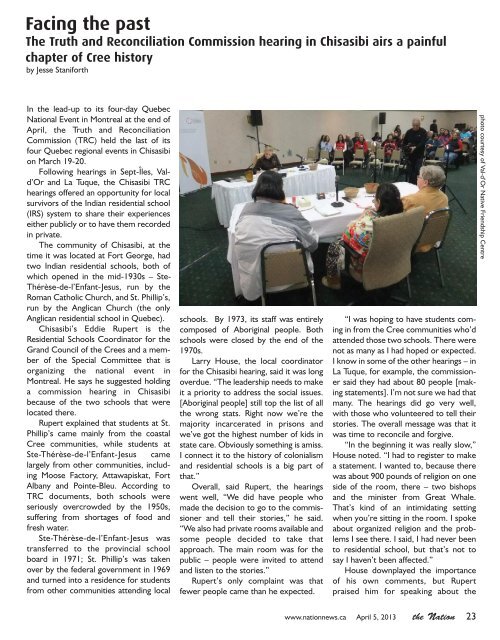Nation-20-11
Nation-20-11
Nation-20-11
Create successful ePaper yourself
Turn your PDF publications into a flip-book with our unique Google optimized e-Paper software.
Facing the past<br />
The Truth and Reconciliation Commission hearing in Chisasibi airs a painful<br />
chapter of Cree history<br />
by Jesse Staniforth<br />
In the lead-up to its four-day Quebec<br />
<strong>Nation</strong>al Event in Montreal at the end of<br />
April, the Truth and Reconciliation<br />
Commission (TRC) held the last of its<br />
four Quebec regional events in Chisasibi<br />
on March 19-<strong>20</strong>.<br />
Following hearings in Sept-Îles, Vald’Or<br />
and La Tuque, the Chisasibi TRC<br />
hearings offered an opportunity for local<br />
survivors of the Indian residential school<br />
(IRS) system to share their experiences<br />
either publicly or to have them recorded<br />
in private.<br />
The community of Chisasibi, at the<br />
time it was located at Fort George, had<br />
two Indian residential schools, both of<br />
which opened in the mid-1930s – Ste-<br />
Thérèse-de-l’Enfant-Jesus, run by the<br />
Roman Catholic Church, and St. Phillip’s,<br />
run by the Anglican Church (the only<br />
Anglican residential school in Quebec).<br />
Chisasibi’s Eddie Rupert is the<br />
Residential Schools Coordinator for the<br />
Grand Council of the Crees and a member<br />
of the Special Committee that is<br />
organizing the national event in<br />
Montreal. He says he suggested holding<br />
a commission hearing in Chisasibi<br />
because of the two schools that were<br />
located there.<br />
Rupert explained that students at St.<br />
Phillip’s came mainly from the coastal<br />
Cree communities, while students at<br />
Ste-Thérèse-de-l’Enfant-Jesus came<br />
largely from other communities, including<br />
Moose Factory, Attawapiskat, Fort<br />
Albany and Pointe-Bleu. According to<br />
TRC documents, both schools were<br />
seriously overcrowded by the 1950s,<br />
suffering from shortages of food and<br />
fresh water.<br />
Ste-Thérèse-de-l’Enfant-Jesus was<br />
transferred to the provincial school<br />
board in 1971; St. Phillip’s was taken<br />
over by the federal government in 1969<br />
and turned into a residence for students<br />
from other communities attending local<br />
schools. By 1973, its staff was entirely<br />
composed of Aboriginal people. Both<br />
schools were closed by the end of the<br />
1970s.<br />
Larry House, the local coordinator<br />
for the Chisasibi hearing, said it was long<br />
overdue. “The leadership needs to make<br />
it a priority to address the social issues.<br />
[Aboriginal people] still top the list of all<br />
the wrong stats. Right now we’re the<br />
majority incarcerated in prisons and<br />
we’ve got the highest number of kids in<br />
state care. Obviously something is amiss.<br />
I connect it to the history of colonialism<br />
and residential schools is a big part of<br />
that.”<br />
Overall, said Rupert, the hearings<br />
went well, “We did have people who<br />
made the decision to go to the commissioner<br />
and tell their stories,” he said.<br />
“We also had private rooms available and<br />
some people decided to take that<br />
approach. The main room was for the<br />
public – people were invited to attend<br />
and listen to the stories.”<br />
Rupert’s only complaint was that<br />
fewer people came than he expected.<br />
“I was hoping to have students coming<br />
in from the Cree communities who’d<br />
attended those two schools. There were<br />
not as many as I had hoped or expected.<br />
I know in some of the other hearings – in<br />
La Tuque, for example, the commissioner<br />
said they had about 80 people [making<br />
statements]. I’m not sure we had that<br />
many. The hearings did go very well,<br />
with those who volunteered to tell their<br />
stories. The overall message was that it<br />
was time to reconcile and forgive.<br />
“In the beginning it was really slow,”<br />
House noted. “I had to register to make<br />
a statement. I wanted to, because there<br />
was about 900 pounds of religion on one<br />
side of the room, there – two bishops<br />
and the minister from Great Whale.<br />
That’s kind of an intimidating setting<br />
when you’re sitting in the room. I spoke<br />
about organized religion and the problems<br />
I see there. I said, I had never been<br />
to residential school, but that’s not to<br />
say I haven’t been affected.”<br />
House downplayed the importance<br />
of his own comments, but Rupert<br />
praised him for speaking about the<br />
www.nationnews.ca April 5, <strong>20</strong>13 the <strong>Nation</strong> 23<br />
photo courtesy of Val-d’Or Native Friendship Centre


